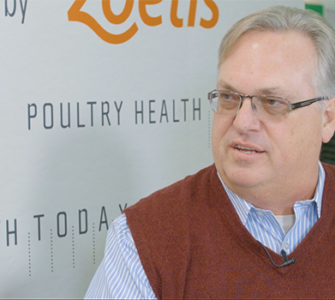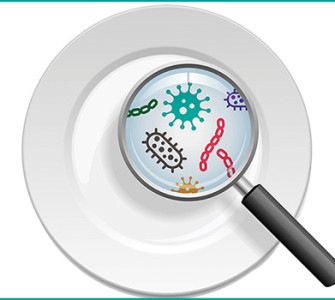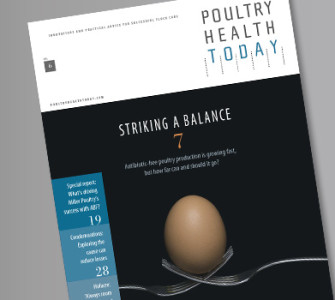Striking a balance with ABF poultry production
Back in 2013, less than 5% of the chicken produced in the US was raised without antibiotics. Most of it came from small, regional commercial poultry companies. A few large integrators dabbled in antibiotic-free, or ABF, production, either to tap emerging markets or to gain some experience — just in case the day came when they’d have to stop using antibiotics.
Then the day came.
On February 11, 2014, Atlanta-based Chick-fil-A — one of the fastest-growing fast-food chains in the nation — stunned the industry by announcing plans to serve only chicken raised without antibiotics within 5 years.
Not wanting to be outdone, a few other restaurant chains and food retailers — Panera, Chipotle and Papa John’s, to name a few — either reconfirmed or initiated their own plans to serve only poultry meat raised without antibiotics.
The trend also rang a bell at some schools and colleges. In December 2014, for example, six school districts that make up the Urban School Food Alliance — New York City, Los Angeles, Chicago, Dallas, Miami-Dade County and Orlando — announced plans to purchase and serve only poultry raised without antibiotics. The University of Massachusetts-Amherst adopted a similar policy in August 2015.
Meanwhile, FDA was moving ahead with new rules to limit the use in food animals of antibiotics that are considered medically important to humans.
The US poultry industry was also taking measures of its own to curtail antibiotic use. For example, the American Association of Avian Pathologists (AAAP) and the American Veterinary Medical Association issued a joint statement suggesting that the routine use of medically important antibiotics in the hatchery to help prevent bacterial infections in embryos was not “judicious use.”
Perfect storm
So there it was — the perfect storm of market, regulatory and industry initiatives gathering on the horizon and sending a daunting message to the US poultry industry: Stop using antibiotics or, at the very least, cut back on them quickly while exploring sound alternatives.
Almost overnight, ABF production in the US began building steam as more poultry companies announced plans to allocate a percentage of their production to this market.
By 2015, 12% of broiler-feed tonnage was made specifically for ABF programs — a four-fold increase from the previous year, according to Greg Rennier, PhD, of Rennier Associates. (See related article for more numbers.)
Pushing back
Despite its fast growth over the past year, however, not everyone in the US poultry industry was ready to hop aboard the ABF train. Some even suggested taking a different route altogether.
For example:
- The Center for Food Safety and American Association for the Prevention of Cruelty to Animals expressed concern for flock welfare as poultry companies gravitated to ABF production. Their joint statement noted that “eliminating the routine use of these drugs without addressing the birds’ underlying health problems…will only result in worse animal welfare and, potentially, reduced food safety.”
- Not wanting to shut the door on antibiotics altogether, fast-food giant McDonald’s USA announced in March 2015 that it would only source chicken raised without antibiotics “that are important to human medicine” according to World Health Organization guidelines. That distinction left the door open for the continued use of ionophores, a class of antibiotics needed to prevent coccidiosis, a highly prevalent and costly parasitic gut disease of poultry.
- At a Wall Street forum in May 2015, the chairman of Sanderson Farms — the country’s third largest producer — pushed back on ABF production, telling investors the company had “no plan to withdraw antibiotics from our program.” Joe Sanderson also gave three reasons why: animal welfare, sustainability and food safety. A year later, Sanderson Farms launched an ad campaign claiming that all chicken was antibiotic-free by the time it reached consumers and railed against what it called “marketing gimmicks designed to mislead consumers and sell products at a higher price.”

The trend also rang a bell at some schools and colleges. In December 2014, for example, six school districts that make up the Urban School Food Alliance — New York City, Los Angeles, Chicago, Dallas, Miami-Dade County and Orlando — announced plans to purchase and serve only poultry raised without antibiotics. The University of Massachusetts-Amherst adopted a similar policy in August 2015.
- In May 2015, recognizing the inherent risks associated with an all-or-nothing approach to antibiotic management, the Pew Charitable Trusts — a non-profit think tank focused on policy and consumer interests — introduced certified responsible antibiotic use (CRAU), the first and only USDA-verified standard for antibiotic use. It requires poultry producers to minimize use of antibiotics important to human medicine and use them only under veterinary supervision. Two of the nation’s leading poultry producers now offer CRAU chicken, which many of the country’s major school districts have committed to purchasing and serving, Pew reported. Pew hopes to bring CRAU to the retail level.
- In October 2015, Subway, which has more than 27,000 restaurants in the US, said it was “beginning to transition to serving only protein from animals that have never received antibiotics.” Shortly afterward, Subway clarified its position and said that while its goal is to reduce and eliminate the use of antibiotics in the food it serves, it recognizes antibiotics are “critical tools for keeping animals healthy and that they should be used responsibly to preserve their effectiveness in veterinary and human medicine.”
- On the heels of McDonald’s antibiotic announcement, parent companies of other major strip-mall restaurants — Wendy’s, Pizza Hut, Hardee’s, Olive Garden, Longhorn Steakhouse, Dunkin Donuts, to name a few — served up their policies allowing responsible use of antibiotics for managing disease. “We believe that responsible animal care guided by a veterinarian is essential to producing high-quality, safe food, while also enhancing consumers’ trust and confidence in the food we all share,” Wendy’s said in an August 2016 statement. “We also believe that sick animals deserve to be treated and that antibiotics should only be used to treat illness.”
- In February 2016, the AAAP issued a position paper strongly defending the rights of licensed veterinarians to treat sick birds with FDA-approved antibiotics that prevent pain and suffering. In a follow-up paper on animal welfare, AAAP reminded the industry that poultry health and welfare “should not be sacrificed in the name of marketing.”
- Prior to the landmark Chick-fil-a announcement, the Animal Welfare Institute (AWI) — a non-profit group that established the widely recognized “Five Freedoms” standards — said it supported responsible antibiotic use but spoke out strongly against the ABF initiative. “At best, the antibiotic-free campaign is a naïve, ill-conceived, knee-jerk reaction” to the antibiotic controversy, according to an article on the welfare group’s website. It went on to describe ABF production as “nothing more than an elitist marketing ploy.”
‘Second-class meat’?
AWI also asked a thought-provoking question about the ABF trend that has yet to find a straight answer:
“On the one hand the antibiotic-free campaigners are publicly demanding that retailers must only source meat, milk and eggs from animals certified by an antibiotic-free program.
“Yet on the other they’re saying that it’s acceptable for farmers in these programs to treat their animals with antibiotics on welfare grounds, just as long as they ‘dispose’ of this second-class meat, milk and eggs elsewhere.
“So exactly where do they think this (perfectly acceptable) food should go?”

According to the National Chicken Council, all chicken is “antibiotic-free” in the sense that no violative antibiotic residues are present in the meat due to the withdrawal periods and other precautions required by the government and observed by the chicken companies.Chicken labeled “raised without antibiotics” or “no antibiotics ever” is from birds not fed antibiotics but, in most flocks, still receive FDA-approved coccidiostats in their feed to help prevent coccidiosis.Both types of birds are routinely vaccinated to help protect against respiratory and other infectious diseases.
As for product labeling, “antibiotic-free” is not allowed to be used on a label but may be found in marketing materials not regulated by the USDA or FDA. It means the same thing as “raised without antibiotics” or “no antibiotics ever.”
Polarizing issue
ABF production is probably the most polarizing issue facing the US poultry industry — one that implies that poultry raised without antibiotics is healthier, safer or more wholesome, even if there’s no scientific data to support those conclusions.
Nevertheless, barring any major production setbacks, it is expected that ABF production will continue to grow — possibly reaching 25% to 30% in 5 years as the industry makes adjustments to meet surging demand.
What’s not certain is how far ABF can go while still being sustainable and meeting the protein needs of all consumers — not just the ones who can afford the higher priced “raised without antibiotics” brands.
Higher prices
While retail prices fluctuate, USDA reports that so-called “specialty” skinless chicken breasts — those from birds raised without antibiotics — cost $4.99 to $5.03 a pound in the last 2 weeks of December 2016. That‘s about 150% more than the value-pack chicken breasts ($2.01 to $2.04) that came from conventionally raised birds. During the same period, skinless chicken breasts from certified organic birds cost even more — $7.36 to $7.90 a pound.
Critics of this trend note that while conventionally raised chickens are given FDA-approved antibiotics under veterinary supervision to prevent, control or treat disease, strict medication-withdrawal times and USDA inspections ensure the meat is still free of antibiotic residues (by USDA standards) by the time it reaches consumers. So in essence, it’s all ABF in the meat case or restaurant, but consumers are willing to pay a premium for how the birds are raised.
“Here’s the unfortunate part: If we don’t have a total change in consumer attitudes, we’re going to be in trouble. I’m a big proponent of more judicious use, but I don’t think antibiotic-free production is sustainable for the long term,” said Yvonne Vizzier Thaxton, PhD, professor and director, Center for Food Animal Wellbeing, University of Arkansas.
“We’ve got customers who think they’re eating antibiotics. That’s not true, of course, but we as an industry send that message when we use antibiotic-free as a marketing tool. As long as we keep doing that, or until we can change that perspective, consumers are going to ask for it.”
Burned by drought?
One other unknown to ponder: ABF flocks typically convert feed 5 to 10 points (0.05 to 0.10) less efficiently than broilers with good intestinal health, according to a veterinarian for a leading poultry company with access to production industry statistics. That in turn leads to higher production costs, said the veterinarian, who agreed to speak with Poultry Health Today but not for attribution, plus more waste in terms of grain, manure and energy.
These losses might be manageable when corn is under $4 a bushel and soybeans under $10, as was the case in 2015 and into 2016. Contrast that with 2012, when a historic drought scorched the US grain belt and drove corn and soybean prices above $7 and $16, respectively. It took 2 years for these prices to return to pre-drought levels.
How ABF production will weather the next drought is anyone’s guess, but history suggests that production models built on lower efficiency and higher prices could be more difficult to maintain with rapidly escalating costs for feed, which typically accounts for 70% of live-production costs.
‘Still in for some surprises’
“Antibiotic-free production is not going away, but it’s still in for some surprises,” Thaxton predicted. “A major drought probably would not have an impact on the use of antibiotics, but it most definitely could have an impact on the retail cost of what is already a more expensive product.”
In addition, if market conditions lead to shortages of poultry raised without antibiotics, or if the product became too costly for most consumers, would some fast-food chains need to start asterisking their “no antibiotics ever” menus with disclaimers like “when available”? Even with increased ABF production, Thaxton thinks that scenario is inevitable.
“What happens when retailers can’t find somebody to supply all their ABF birds — whether it’s drought or because they’ve got a recurrence of diseases that we haven’t seen in years, which I think is going to happen in flocks where we stop using antibiotics altogether?” she asked.
“There may not be enough antibiotic-free chicken for their programs at any cost. They’d probably have to do what I call the ‘Chipotle cop-out,’ where they put a sign up saying they’re unable to provide a certain kind of meat at this time.”
Thaxton was referring to reports of Chipotle occasionally running short of poultry, pork or beef raised to the company’s standards and having to use alternatives at some retail locations.
Numbers out of context
There’s also the question of how far poultry ABF initiatives will go to address the real issue: reducing the threat of antibiotic resistance in humans.
Agriculture has long been a target for activists, who like to point out that 70% of antibiotics in the US are used in farm animals. But when one compares a US population of 318 million people to 9 billion broiler chickens, 253 million turkeys, 92 million cattle, 66 million hogs and 5 million sheep, it’s easy to see how antibiotic-consumption numbers get blown out of proportion.
Recognizing that volume is not an accurate measure of antibiotic usage in any species, FDA is working with USDA, Centers for Disease Control and the major animal-health companies to improve data collection on resistance patterns and antimicrobial usage.
In 2016, FDA told Poultry Health Today it had partnered with four states to perform whole-genome sequencing on samples provided by the National Antimicrobial Resistance Monitoring System. The data “will provide unprecedented details on changes in resistance genes from animals and animal-derived foods,” the agency said.
Lightning rod
Another huge issue is human medicine‘s contribution to antibiotic resistance. According to a study published in 2016 in the Journal of the American Medical Association (JAMA), nearly one-third of antibiotics prescribed in the US in outpatient settings are unnecessary. Researchers also found that doctors write about 47 million needless antibiotic prescriptions each year, JAMA reported.
It therefore begs the question: Why has the poultry industry become the lightning rod for this issue when, according to Rennier, about 81% of the feed antibiotics used in broiler feeds in 2015 were not on FDA’s list of antibiotics medically important to humans?
Furthermore, the amount of medically important antibiotics used in poultry is expected to become even less as poultry companies comply with FDA’s new veterinary feed directive rules in January 2017. No one seems to know why poultry is practically alone in consumers’ antibiotic spotlight, but it’s clear that the people who produce poultry meat are working hard to adapt to and meet the needs of all consumers.
See related articles:
Fast growth seen for ABF poultry production, but for how long?
Posted on June 24, 2017

















